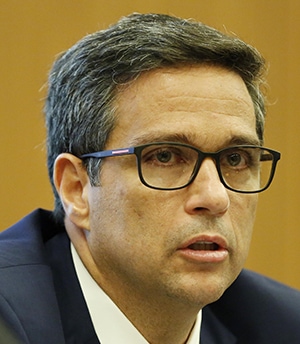The president of the Central Bank of Brazil talks to Global Finance.

Global Finance: What is your view of the Brazilian economy for the coming year?
Roberto Campos Neto: The outbreak of the Covid-19 pandemic imposed significant strains on the Brazilian economy. In the first quarter of 2020, Brazilian GDP contracted by 2.5% compared to the previous quarter. Most of the impact, however, was felt in the second quarter of 2020, when GDP dropped 9.7% against the previous quarter. Despite these negative numbers, recent data already suggest a partial recovery in economic activity. PMI data, for instance, show that manufacturing in Brazil is recovering faster in comparison to other emerging market economies.
In this context of crisis, the Brazilian government and the Central Bank of Brazil (BCB) implemented a set of measures to try to mitigate the economic impacts of the pandemic.
On the monetary front, the BCB decreased the policy rate from 4.25% to 2.00% per year. As macro-financial measures, the BCB reduced capital requirements and implemented several measures to ensure that the financial system remained liquid and properly functioning. With these and other initiatives, the BCB implemented the highest liquidity injection and capital relief ever in Brazil. Overall, the measures adopted by the BCB freed up to 1.27 billion Brazilian real, or 17.5% of GDP, in liquidity and BRL 1.45 billion, or 20% of GDP, of capital in the financial system.
On the fiscal side, the government implemented direct transfers (Emergency Aid) to help the most vulnerable and adopted measures of tax relief and tax deferrals to households and firms. The government transfer programs have allowed for a strong resumption of durable goods consumption. However, several service-sector activities, especially those most directly affected by social distancing measures, remain quite depressed.
Looking forward, we expect a gradual recovery of the economy. Brazilian GDP is expected to fall 5.5% in 2020 and grow 3.5% in 2021, according to current market forecasts.
GF: What are the main risks linked to the current crisis and what can the central bank do?
Campos Neto: Despite some promising signs of recovery there are still several risks on the horizon. For activity, two risks are important: 1) a delay in finding an effective vaccine or treatment for Covid-19, and 2) the impact of the “scaring effect.” We saw that even where restrictions have been eased, there are frequent reports of depressed revenues, which suggest that household behavior responds to pandemic-related risks even in absence of government-imposed restrictions.
There are also risks related to the global outlook. The external scenario presents an extraordinary level of uncertainty, for both advanced and emerging economies. Uncertainties about a second wave and possible persistent effects on potential output are important risks. Our understanding is that, for emerging economies, the external scenario continues to present a high probability of episodes of high asset-price volatility and contractions in risk appetite.
We consider that possible new interest rate reductions would demand caution and additional gradualism. To this end, if necessary, further interest rate cuts would require greater clarity about prospective inflation and activity, and could be spaced over time.
GF: With inflation at bay, what are the main risks for the economy for the next 12 months?
Campos Neto: We have been highlighting that our baseline scenario for inflation encompasses risk factors in both directions. On the one hand, economic slack may continue to produce a lower-than-expected prospective inflation trajectory. This risk increases if a slower reversion of the pandemic effects lengthens the environment of high uncertainty and precautionary savings. On the other hand, fiscal policy responses to the pandemic that permanently aggravate the fiscal path, or frustrations regarding the continuation of the reform agenda, may increase the risk premium. The fiscal room was already small before the Covid-19 pandemic, and became still more limited after the measures required to mitigate the negative social effects of the crisis, with a rapid increase in the debt/GDP ratio. The BCB does not foresee reductions in its monetary stimulus unless inflation expectations, as well as its baseline scenario inflation projections, are sufficiently close to the inflation target at the relevant horizon for monetary policy, which currently includes 2021 and, to a lesser extent, 2022.
GF: What is the outlook for Latin America overall?
Campos Neto: Although so far Latin America countries dealt well with financial spillovers, the real side of their economies has been hard hit by the Covid-19 crisis. The current situation in the region demands higher government spending not only to support the countries’ health systems, but also to grant income for more-vulnerable households and avoid extreme poverty. Latin American countries will emerge from this crisis more indebted and facing more social inequality. bably the recovery to pre-crisis production levels will not be seen until 2022 or later.



